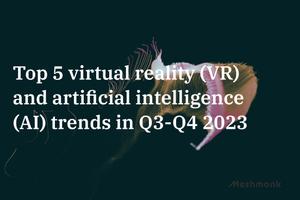Top 5 VR and AI trends in Q3-Q4 2023
Welcome to the cutting edge of technology! In this blog, we’re diving into the fascinating world of Virtual Reality (VR) and Artificial Intelligence (AI) – a realm where innovation is not just a buzzword, but a daily reality. Recent months have witnessed groundbreaking developments that are reshaping how we interact with digital environments, revolutionize urban planning, and even redefine human-robot interactions. From Meta’s VR headsets integrated with EEG sensors to shape-shifting 3D displays, and AI-driven bimanual robots, the advancements are not just futuristic; they’re happening right now. Join us as we explore the top five developments in VR and AI from the last six months, showcasing how these technologies are not just changing the game but also setting the stage for a future that’s more interactive, immersive, and intelligent than ever before.
-
Meta VR Headset with EEG Sensor (August 4, 2023): The University of Texas at Austin’s research team has innovatively integrated a noninvasive electroencephalogram (EEG) sensor into a Meta VR headset. This breakthrough allows for the monitoring of brain activity while users are engaged in virtual reality experiences. The significance of this development lies in its potential applications in neuroscience research, gaming, and therapeutic interventions, offering a new dimension of interaction and user experience in virtual reality.
-
Shape-Shifting 3D Display Technology (July 31, 2023): Engineers have developed a groundbreaking shape-shifting display that can be adjusted to fit various surfaces, such as a card table. This technology enables users to interact with and create 3D designs in a more tangible and immersive manner. The display’s ability to change shape and adapt to different environments opens up new possibilities in design, education, and entertainment, making digital interactions more dynamic and engaging.
-
Virtual Reality in Urban Planning (July 14, 2023): Virtual reality tools are being increasingly employed in urban planning to simulate and analyze the impact of structural changes in cities. This application of VR technology allows planners and architects to visualize and explore the effects of their designs on the movement and experience of people within urban spaces. By creating immersive simulations of proposed urban environments, VR is enhancing decision-making processes in urban development, leading to more efficient and people-centric city planning.
-
3D Digital Models of Historical Neighborhoods (June 28, 2023): A fascinating use of VR technology has been in the recreation of historical neighborhoods through 3D digital modeling. This project involves converting old maps into immersive 3D environments that users can explore using VR headsets. This application not only serves as a tool for historical education and preservation but also provides a unique way for people to connect with and experience the past, bringing history to life in an interactive and engaging manner.
-
Bimanual Robot with AI-Driven Tactile Sensitivity (August 24, 2023): An innovative bimanual robot has been developed, showcasing tactile sensitivity that closely mimics human dexterity. This robot, powered by advanced AI algorithms, represents a significant leap in robotics, offering potential applications in various fields such as manufacturing, healthcare, and service industries. The robot’s human-like tactile abilities enable it to perform complex tasks that require a high level of precision and sensitivity, marking a new era in the integration of AI and robotics.
These developments underscore the rapid advancements in VR and AI technologies and their expanding applications across different sectors. From enhancing user experiences in virtual reality to revolutionizing urban planning and robotics, these technologies are setting new benchmarks in innovation and practical applications.

